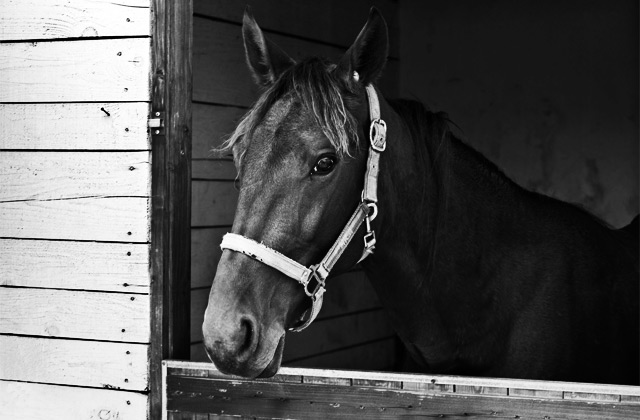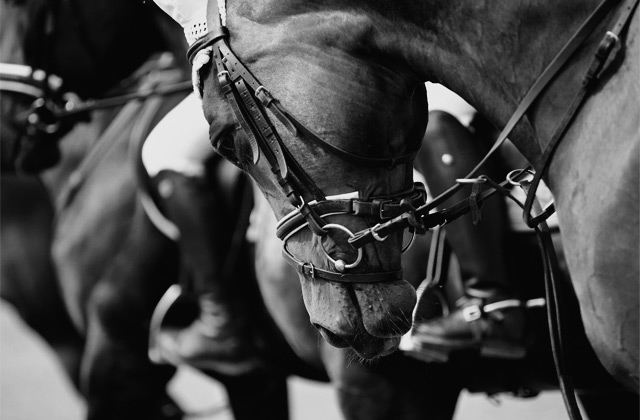The bustling stands; chewing the fat before the race; the thrill of betting and the suspenseful quiet ensued by a thunderous commotion when the gates open. These are a few of many elements that make every horse race such a riveting sport.
But it is the horses themselves that are at the center of this engaging spectacle. Once the finish line has been crossed, it is the name of the winning horse that first escapes the commentator’s mouth. And (mostly) it is the name of the winner that is committed to memory for generations to come. But there are winners and winners.
Below we give you a list of the ten of the most famous racehorses that have graced the racetrack and left an indelible mark on the sport.

History’s Top 10 Most Famous Racing Horses
Over the decades, the best racing horses in the industry have earned an almost cult-like status among millions of horse racing admirers. Some horses are one-race-wonders, something that horse racing betting sites love, others more consistent in their achievements and performances in top races such as the Belmont Stakes, Kentucky Derby, or the Breeder’s Cup Classic.
But to make it to the ‘most famous racehorses in history’ list takes a special breed of horse. Winning the US Triple Crown trophy is almost an express ticket to glory. But it’s not a guarantee. Sometimes a horse wins over the fans and leaves a lasting impression regardless of the number or types of races and trophies won.
The following list includes what are generally considered to be the most successful and famous racehorses of all time. Some raced decades apart, others’ racing careers overlapped; some even sired future legends and were grandsires of later iconic champions whose lineage is still alive today.
Man o War
Man of War is a thoroughbred racehorse of epic proportions. Yet he is no Triple Crown winner. Of the three races, he won the Preakness Stakes and the Belmont Stakes in 1920. Yet that does not, in the least, diminish his place in history. Just to clarify, he did not lose the Kentucky Derby, rather did not enter the race (due to logistical reasons) to begin with.
With a raging temper and imposing physical disposition (was nicknamed Big Red), this awe-inspiring creature is often credited with reviving horse racing in the US between the wars. As one commentator pleasantly put it, Man o War had ‘an aura of untouchable regality’ about him, comparing touching Man o War akin to touching the Queen.
In an illustrious racing career, the legendary Man o War had won at least 20 important races. The Jockey Club Gold Cup, Withers Stakes, and the Kenilworth Park Gold Cup, later renamed to Man o’ War Cup, are just a few to name. He finished his career with a 21: 20–1–0 record and is an inductee in both the US and Canadian Racing Hall of Fame.
Man o War remained an icon even after his career had finished, and long after he died at the ripe age of 30 in 1947. Among his many accolades are American Horse of the Year (1920) and Leading sire in North America. He is the sire of the noted champion War Admiral and grandsire of the equally as famous Seabiscuit.
War Admiral
Offspring of the mighty Man o War, Triple Crown winner War Admiral followed in his father’s hoofsteps and was the most outstanding racehorse in the mid-to-late 1930s. As a two-year-old stallion in 1936, War Admiral won the Great American Stakes and Eastern Shore Handicap.
But it was the following year that would establish him as one of the best racing horses of the century and earn him the title US Horse of the Year (1937). As a three-year-old stallion, War Admiral won several important thoroughbred races, including the Chesapeake Stakes.
Owner Samuel Riddle, who also owned Man o War, entered the three-year-old War Admiral in the Kentucky Derby as the favorite. News that the direct descendant of Man o War would join the Derby caused a euphoric stir about the race. He won in a neck-to-neck race from start to finish with three-year-old 1936 champion Pompoon, who defeated War Admiral in the National Stallion Stakes the year before.
War Admiral ultimately won all three Triple Crown jewels. In a third face-off and another nail-biter with Pompoon, he won the Preakness Stakes. He entered the Belmont Stakes as the favorite with 4-5 odds. War Admiral rushed to victory after a rocky start where he initially stumbled and injured his right front leg, becoming the 4th North American Triple Crown champion. He even beat his father’s track record by a 5th of a second.
War Admiral was a high-earning and decorated stallion, earning over $273,000 in his racing career, which ended with a shining record of 21 wins from 26 starts. Another rivalry that also contributed to War Admiral’s fame was that with Seabiscuit, which we’ll discuss next.
Seabiscuit

Another famous racehorse from the 1930s whose name still resonates today. Seabiscuit’s early career got off to an uncertain start. Due to his small stature and his eating-and-sleeping-centered habits, Seabiscuit did not show much promise as a young colt, despite being trained by champion trainer James Edward Fitzsimmons.
Initially competing in low-scale tournaments, Seabiscuit had underperformed and lost in over 15 races. He first drew attention after winning and setting a record during one claiming stakes race at Narragansett Park. As a two-year-old, Seabiscuit had a pretty uneventful career, although his true talent, as time will show, turned out to be greatly underappreciated. In the nearly three-dozen races as a two-year-old, he won five, three of which were claiming contests where he had no buyers, despite being priced relatively low.
Undervalued, undesired, and underrated, Seabiscuit’s career was headed to an uninspiring finish. That is, until he was noticed by trainer Tom Smith in 1936. With Smith and jockey Red Pollard at the helm, he won various races across the country, including World’s Fair Handicap and the San Juan Capistrano Handicap. Throughout the 1937 season, he won multiple important contests, despite running with greater weights.
Seabiscuit ended the 1937 season with 11 wins of 15 races and was a close contender for American Horse of the Year – an award ultimately won by War Admiral. In 1938 Seabiscuit and War Admiral crossed paths in the Pimlico Special in what was touted as the Match Race of the Century. Despite War Admiral’s favorite status, Seabiscuit, the grandson of Man o War, won by four lengths and broke the track record. That same year, Seabiscuit and War Admiral were again contenders for America’s biggest horse award. Seabiscuit won by over 200 points.
Secretariat
An enigmatic racing powerhouse, the story of Secretariat is one steeped in unprecedented success and tragedy. Always making the lists for the ‘most famous horses of all time,’ Secretariat raised the bar for horse racing to such unreachable heights that no other horse has since come close to matching his achievements. That’s no overstatement.
Secretariat is quite possibly the fastest horse in history and in 1973 became the first horse to win the Triple Crown races in 25 years. But not only did he win the Triple Crown, he also wiped the floor with the competition, setting track records in all three Triple Crown races that remain unbeaten to this day.
The horse racing world was bracing to see something exceptional from Secretariat after by age two (1972) he had already won seven of nine starts and was named Horse of the Year. He was only the second two-year-old racehorse to receive the honor.
Secretariat’s win at the 1973 Belmont Stakes left the nearly 70,000 spectators befuddled. It was a spectacle horse racing fans had not witnessed until then, or ever since. After setting track records at the Kentucky Derby and Preakness Stakes, Secretariat won the Belmont Stakes an incredible 31 lengths ahead of the runner-up, likely setting a Belmont Stakes record (2:24) for all time.
A racing oddity and the subject of various books, analyses, and an eponymous film, who has his own Post Mark, it is impossible to describe this almost-mythical being and not feel at a loss for words. To say that he is just one of the best race horses of all time would be an understatement. In ESPN’s list of top 50 athletes of the 20th century, Secretariat is the lone non-human listing.
Once a formidable and almost unstoppable force on the racecourse, who set still-unbeaten track records in all Triple Crown events, Secretariat was ultimately put down after being diagnosed with incurable hoof disease.
When the necropsy of Secretariat was completed it revealed a remarkable anomaly: his heart, which was in perfect health, was two-and-a-half times bigger than that of the average racehorse.
American Pharoah

A descendant of three of the best racing horses of all time – Man o War, War Admiral, and Native Dancer – American Pharoah is one of few contemporary racehorses to scribe their names in the annals of horse racing.
He placed fifth in his maiden race at age two but won the next two Grade I races by a significant margin. This earned him the title of American Champion Two-Year-Old Male Horse for 2014. The following year was the year American Pharoah became a household name in the racing industry.
In 2015, the three-year-old stallion won the Triple Crown and went on to win the Breeders Cup Classic later that year, completing the Grand Slam of Thoroughbred Racing. To date, he is the only horse in history to achieve this feat.
While brief, American Pharoah’s three-year racing career proved enough to immortalize him as the first and so far only US Grand Slam Champion. He was voted the United States’ top horse for the 2015 season, after which he retired.
Seattle Slew
Except for Secretariat, Seattle Slew was one of the most dominant thoroughbred racing horses of the 1970s. As a young horse, Seattle Slew was seen as inauspicious due to his small and odd conformation.
Seattle Slew’s first major breakthrough came in 1976, when as a 2-year-old he won the Grade I Champagne Stakes against favorite For the Moment, setting a record at the time. Even though in 1976 Seattle Slew had only three starts, he was dubbed American Champion two-year-old Male Horse for that year. But it was 1977 that established Seattle Slew as one of the best racing horses of the 1970s, and one of the most famous racehorses for decades to come. That year, Seattle Slew reached the peak of his career when he won the Kentucky Derby and Preakness Stakes, completing the Triple Crown trophy with a win at the Belmont Stakes.
In front of a crowd numbering over 120,000 people at the Churchill Downs, Seattle Slew won the Kentucky Derby, albeit running below expectations. Ahead of the Preakness and Belmont Stakes, Seattle Slew had trained hard, winning and setting one of the best times ever in the Preakness Stakes in a narrow race with Jersey Derby winner Cormorant. In a more relaxed, four-length victory against Run Dusty Run in the 1977 Belmont Stakes, Seattle Slew became the tenth North American Triple Crown winner. His claim to the Triple Crown came in one of the most competitive years in the history of the sport, effectively placing Seattle Slew among the most famous racing horses in history.
Along with Justify (2018), Seattle Slew is the only horse to have won the Triple Crown event with a 100% winning streak leading up to the Triple Crown campaign. It’s worth noting that Justify is a descendant of Seattle Slew.
Hurricane Fly
Alongside Red Rum, Hurricane Fly is among the most famous racehorses in the UK and Ireland. Famous for his stellar performances both in flat and hurdle contests, as a two-year-old gelding (2006-2007), Hurricane Fly had a somewhat lackluster start in flat racing.
The next two years established Hurricane Fly as a budding hurdles champion. The now-three-year-old initially competed in multiple Novice Hurdle races before ultimately winning three major Grade I races in Ireland that season. These included the Royal Bond Novice Hurdle, the Future Champions Novice Hurdle, and the Evening Herald Champion Novice Hurdle.
After getting back at fellow gelding Solwhit at the Grade I Punchestown Champion Hurdle in 2010, he began the following National Hunt season with five consecutive wins, beating Solwhit two more times in Grade I contests.
By 2013, Hurricane Fly had already attained worldwide fame. But it was likely his success in the 2014/15 season winning his fifth consecutive Irish Champion Hurdle that earned him stature as one of the most famous racing horses. He is currently the only five-time winner of the Champion Hurdle for five consecutive years between 2011 and 2015.
Winx
Foaled in 2011, Winx is easily one of the most famous racehorses of the past decade. She currently holds the world record for most Grade I race trophies. In total, from 2015 till 2019, she won 33 straight races.
Despite having a small stride of just 22.2 ft, she was estimated to run 14 strides in five seconds, against the 12 of her average competitor. Winx was voted the highest-ranked fillie in the world for three consecutive years between 2016 and 2018. Only one other horse can be on a par with these figures, and that is World and European Champion Sprinter Black Caviar.
Alongside Black Caviar, Winx is only the third horse ever to be inducted into the Australian Racing Hall of Fame while in training. For four consecutive seasons between 2015 and 2018, she was voted Australian Horse of the Year. By the end of her incredible four-year run, she had won 25 Grade I races and earned over AUD $26 million, close to USD $19 million.
Red Rum
Red Rum is one of the most famous racehorses in the history of steeplechase races. To date, he remains the only racehorse to win the U.K.’s Grand National race three times (1973,1974, and 1977).
The gelding was initially groomed for shorter, sprint races, yet ended up being an undisputed Grand National champion in long-distance races run at over four miles. As a two- and three-year-old, Red Rum competed mostly in sprints and low-scale contests, and even recorded several wins at the Warwick and Doncaster racecourses.
Then came a period where he was moved from one training ground to another, before being ultimately bought by trainer Donald “Ginger” McCain. McCain trained Red Rum on sandy beaches in Southport, which is believed to have primed him for the long-distance hurdle contests.
Red Rum established himself as a fan favorite already in the first Grand National race in 1973. Despite at one point trailing Australian steeplechase champion Crisp by 30 lengths, he not only made a remarkable comeback and won the race but also set a new record. He reprised his success the following year (1974). He finished second in the 1975 and 1976 Grand National, only to come back even stronger in 1977 (aged 12) and win his record third Grand National in what many horse racing pundits consider one of the most remarkable achievements in the history of the sport.
Zenyatta
A commanding queen among the stallions, Zenyatta’s reputation is only outshined by her remarkable career. A mare sired by Street Cry – who also sired Winx – she was a late bloomer, winning her maiden race as a three-year-old in late 2007.
Zenyatta has a near-spotless record of 19 wins of 20 starts and total career earnings of over $7 million. Her biggest achievements came between 2008 and 2010, during which time she won 17 straight-graded races, 13 of which were Group One (or Grade 1) contests. Among the noteworthy Grade I wins include the Vanity Handicap, Clement L. Hirsch, and Apple Blossom Handicap. But the one that secured her place in history was the Breeders Cup Classic.
In the 2009 Breeders Cup, she faced a series of A-listers, including Rip Van Winkle and Twice Over (who were the favorites), alongside Kentucky Derby winner Mine That Bird, and Belmont Stakes winner Summer Bird.
A rough start had Zenyatta trailing initially more than 15 lengths, then 9, then just over six in the packed track. As she began to gain ground, jockey Mike Smith swayed her to make room as she began barrelling down the last stretch to ultimately win by half a length.
In 2010 she was named American Horse of the Year and six years later was inducted into the National Museum of Racing and Hall of Fame.
History’s Most Famous Racehorses -Honorable Mentions
There are a few more names in the history of the best racing horses that are worth mentioning:
- Native Dancer – the first horse made a celebrity through mass media
- Frankel – one of the best racing horses of the 2010s with a 100% win record
- Northern Dancer – first non-US-bred horse to win the Kentucky Derby
- Black Caviar – named European Champion Sprinter in 2012
- Rachel Alexandra – the first filly to win the Preakness Stakes in 85 years
FAQ
What are the Most Famous Racing Horses in History?
Each generation has a horse that stands out, but names like War Admiral, Man o War, Black Caviar, and Secretariat are sure to echo through the ages for being some of the best race horses.
Which Champion Race Horses Have Won a Triple Crown?
Among the most famous racehorses that have won a triple crown include Seattle Slew, American Pharaoh, Secretariat, and War Admiral.